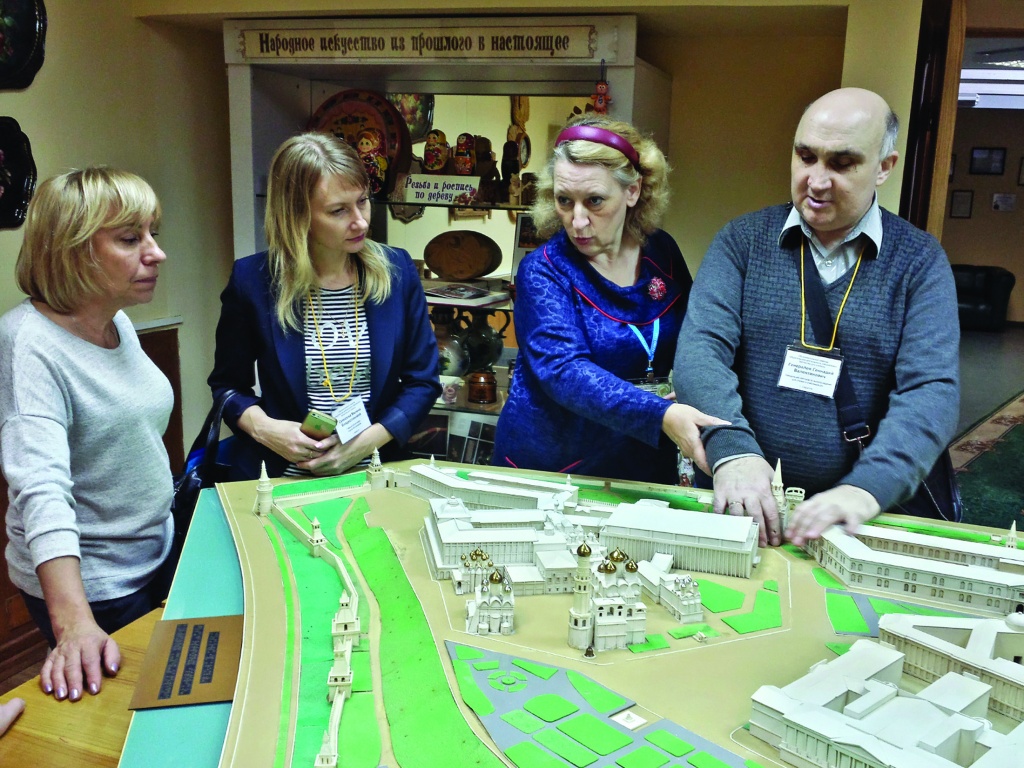Power of influence that Art has on human beings’ spiritual development is generally known. Duty of all institutions of Culture is to help visually-impaired people with perceiving of Art basis and enriching their knowledge in the field of cultural traditions and heritage. Role and potential of special libraries for the blind in this process are the most effective if principals of systematic and composite are lied on a base of work and if rehabilitation methods and means are adequate to possibilities of the blind.

Centre of Art-Aesthetic Rehabilitation is one of the most effective models of aesthetic development of visually-impaired people of different ages. This Centre was organized in the Russian State Library for the Blind in 2001. It includes:
- studio for digital “talking” books recording;
- mini printing complex for issuing of braille documents;
- exhibition hall with collections of architectural monuments’ models, copies of sculptures and items of decorative-applied arts.
Work of the Centre is directed at creating of conditions for independent access of the visually impaired to art and historical values of national and world culture, to expending of possibilities in getting information in accessible for the blind formats. The Centre works in close contact with institutions of culture, art, education and science.
The first experimental records on cassettes were made in the Russian State Library for the Blind in the 70th. The Centre reestablished this work. Some series of audio materials on cassettes and CD-ROMs were recorded on a base of digital technologies in co-operation with art critics, museum workers and artists.
Excursions of museums, art galleries and memory places
The distinguishing feature of this series records is the account about expositions is talked with regard for peculiarities of visually-impaired people’s perception: detailed descriptions of premises, dislocations of objects in halls, their sizes and materials. Accounts of guides are added by musical and literature compositions.
In this series the following audio excursions were issued: “State Historical Museum” (“Archaeology”, “Relics of Russian State”, “Pokrovskiy Cathedral”), “Moscow Museum of Sergey Esenin”, “Moscow Art Gallery of the People’s artist of the USSR Alexander Shilov”, “The main street of the capital”, “Peredvijniki”, “Impressionists”, “Christian motifs in European artists’ works of art”.
Musical and Dramatic Performances
Each part of a performance is supplied by accounts about decorations, actions and costumes of actors. Listeners’ attention is accented on scenic and musical features of a performance.
In this series the following records are available
musical performances:
“Queen of spades” by P.I.Chaykovsky
“Boris Godunov” by M.P.Musorgsky
“The Bat” by I.Shtrauss
dramatic performances:
“Solo for Clock with stricking”
“Don Juan” , ect.
The visually-impaired in the world of art
Encouraging and popularizing visually-impaired people’s creative work the Russian State Library for the Blind has prepared and issued the following materials:
- poetical compositions about the II World war (poems of blind poets);
- musical performances played by visually-impaired musicians.
Sence of touch plays a great role in understanding of the world by visually-impaired people. But perception of architecture is a difficult and multi-steps process demanding a special skills base and a whole set of means of acquaintance. The first step – using of relief pictures. The second one includes work with half–volume pictures created on plastic. The following and the most important step – studying of models giving a whole representation of volumes and forms, proportions and spatial correlation of structures parts allowing to use different materials as much as possible approaching to tactile properties of original objects. The Russian State Library for the Blind started to collect architectural models in the 70th. The first exhibits of the library museum were towers of Moscow Kremlin, churches of Moscow and other Russian cities, other architectural monuments; sculptural portraits of writers, poets, scientists and artists; copies of antique sculptures; models of animalistic sculpture and art ceramics.
Users of the library can look through all these objects at regularly renovated exhibitions “Palpable Beauty” and “To see by the soul”. One of the first exhibits of the Library was the large model of Moscow Kremlin and the Red Square created by masters of Moscow Architectural Institute. This model contains more than 60 objects: buildings, parks, avenues, ect. The model precisely renders the relief of the Kremlin territory.
In the Library there is a large collection of moulds of antique and other sculptures “Laokoon”, “Nefertity”, “Hercules” ect. So, The Russian State Library for the Blind has formed a real art museum that became for the visually-impaired a distinctive window to the world of spatial art.
A great attention pays to national folk trades. Russian folk trades are well known in different countries of the world. Forming this collection the Russian State Library for the Blind made a special accent to tactile and audio properties of folk trade objects to the originality of execution and to the informativeness of details. Toys and decorations give gladness to children and adults.
On a base of the Library the itinerant exhibitions are held. During the last two year visitors of the museum could look through expositions of sculptural works of students of the Russian Academy of art, sculpture and architecture “Tiflo-Art of Moscow”
